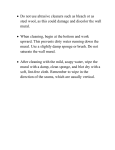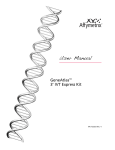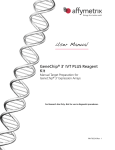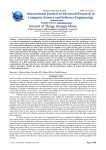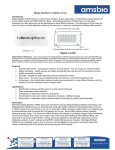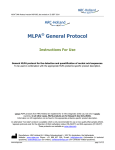Download Appendix B: Troubleshooting the DIG System
Transcript
20766 Appendices.fm Seite 184 Donnerstag, 1. Februar 2001 1:57 13 Appendix B: Troubleshooting the DIG System 1. Possible Problems and Recommendations Appendix B: Troubleshooting the DIG System 1. Possible Problems and Recommendations Problem 1: Too weak or too strong signals A B Possible cause Chemiluminescent assay exposure time too short (A) or too long (B). Recommendation Increase [for (A)] or decrease [for (B)] the amount of time you expose the blot to X-ray film or in the Lumi-Imager. Appendices Note: The display range tool of the LumiImager allows adjustment of the signal intensities (see Section 3.1.2). 184 20766 Appendices.fm Seite 185 Donnerstag, 1. Februar 2001 1:57 13 Problem 2: Uniform High Background Problem 3: Irregular, Cloudy Background Possible causes ● Probe concentration was too high during hybridization (most likely cause). ● Template DNA was contaminated, leading to impure probe. Possible cause Uneven distribution of probe during hybridization, caused by not using enough hybridization solution or by letting the membrane dry during incubation. Recommendation ● Reduce probe concentration ● Perform a mock hybridization with different concentrations of probe (as described in Part 2 of Appendix B, page 194) to determine the amount of probe that gives the most signal with the least background. ● Never use the entire yield from a labeling reaction to analyze a single blot (as you might for radioactive analysis) ● Purify the probe with proteinase K treatment and/or filtration through a 0.45 µm cellulose acetate filter or use the High Pure PCR Product Purification Kit. ● Purify the template by phenol extraction and ethanol precipitation. Recommendation ● Do not add probe directly to prehybridization solution. ● Do not allow membrane to dry between prehybridization and hybridization. For instance, do not pour off the prehybridization solution until the hybridization solution is ready for immediate addition to the membrane. ● Use at least 3.5 ml of hybridization solution per 100 cm² of membrane. Note: If using roller bottles for incubation, use at least 6 ml hybridization solution per bottle. ● Shake the hybridization container during the hybridization incubation. Caution: Make sure that the hybridization bag lies flat in the bottom of the water bath. Appendices Appendix B: Troubleshooting the DIG System 1. Possible Problems and Recommendations 185 20766 Appendices.fm Seite 186 Donnerstag, 1. Februar 2001 1:57 13 Appendix B: Troubleshooting the DIG System 1. Possible Problems and Recommendations Problem 4: Irregular, Smeared, Grainy Background Problem 5: High Background on Only Part of Membrane Possible cause 1 (Data courtesy of Dr. Bacchetti and Dr. Marusic, McMaster University, Canada.) Drying of membrane during chemiluminescent detection procedure. Possible causes ● Non-uniform distribution of chemiluminescent substrate, e.g. due to performing incubation while membrane wrapped in plastic wrap. ● Wrinkles in the hybridization bag, causing uneven contact between membrane and X-ray film. ● Drying of membrane during chemiluminescent visualization procedure. Note: The grainy appearance of the background indicates that the drying occurred during the chemiluminescent procedure rather than during hybridization. Drying during hybridization leads to a cloudy background (as shown in Problem 3). Appendices Recommendation ● Do not wrap membrane in plastic wrap during incubation with chemiluminescent substrate. ● Spread the chemiluminescent substrate uniformly over the surface of the membrane, as described in Section 4.1, page 112 of Chapter 2. ● Before exposing bag to X-ray film, flatten any wrinkles between blot and membrane by rolling a pipette over the surface of the bag. ● Carefully seal the damp membrane (in a folder or bag) during the incubation/exposure to X-ray film. Check the seals to make sure liquid cannot leak. 186 Recommendation ● Do not wrap membrane in plastic wrap during incubation with chemiluminescent substrate. Plastic wrap cannot be sealed and will allow membrane to dry out. ● Carefully seal the damp membrane (in a development folder or hybridization bag) during the incubation/exposure to X-ray film. Check the seals to make sure liquid cannot leak. 20766 Appendices.fm Seite 187 Donnerstag, 1. Februar 2001 1:57 13 Appendix B: Troubleshooting the DIG System 1. Possible Problems and Recommendations [Problem 5 (cont.)] Problem 6: Spotty Background Possible cause 2 (Data courtesy of Dr. Bacchetti and Dr. Marusic, McMaster University, Canada.) Membrane dried while in blocking solution and stuck to side of incubation tray. Possible cause 1 Antibody contained a precipitate when it was applied to the membrane. Recommendation ● Before each use, centrifuge the antibody preparation (in its original vial) for at least 5 minutes at 10 000 rpm. Take an aliquot from the surface of the supernatant for the antibody dilution. ● Be sure the Detection Buffer used after the antibody incubation step does not contain Mg2+ ions. Appendices Recommendation ● Never let membrane dry at any stage of the prehybridization, hybridization, or detection procedures. ● Always use enough liquid in each incubation to cover membrane completely. ● Control the membrane occasionally during incubations (especially those with agitation) to ensure it does not dry or stick to the incubation tray. 187 20766 Appendices.fm Seite 188 Donnerstag, 1. Februar 2001 1:57 13 Appendix B: Troubleshooting the DIG System 1. Possible Problems and Recommendations [Problem 6 (cont.)] [Problem 6 (cont.)] Possible cause 2 Membrane was unsuitable for nonradioactive assay. Possible cause 3 (Data courtesy of T. Ruckes, Institute of Virology, Erlangen, Germany.) Salt crystals (from 20x SSC) were baked into membrane before the detection procedure. Appendices Recommendation Use positively charged Nylon Membranes from Roche Molecular Biochemicals. Recommendation ● Wash the membrane briefly in 2x SSC before baking. ● Do not bake the membrane. Instead, fix the DNA by UV crosslinking, then rinse the membrane with water (as described in Section 3.1.2.2, page 91 of Chapter 2). 188 20766 Appendices.fm Seite 189 Donnerstag, 1. Februar 2001 1:57 13 Appendix B: Troubleshooting the DIG System 1. Possible Problems and Recommendations Problem 7: Gray Circles above Bands Problem 8: Spots on the X-ray Film, in Areas Not Covered by Membrane (Data courtesy of Dr. Bacchetti and Dr. Marusic, McMaster University, Canada.) Possible cause Membrane was too dry before chemiluminescent substrate was added. The substrate dried at several spots on the membrane, leading to the gray circles. Possible cause Electrostatic charge on the outside of the sealed hybridization bag. Recommendation ● Wipe the surface of the sealed bag with 70% ethanol before incubating it with the X-ray film. ● When handling the membrane, always wear gloves. ● Use forceps, never fingers, to grip the membrane. ● Grip only the edges of the membrane, never the center (even with the forceps). Appendices Recommendation ● Do not let the membrane dry (even slightly) before adding the chemiluminescent substrate. ● Cover the membrane with the second sheet of the folder or bag immediately after you add the chemiluminescent substrate (as described in Section 4.1, page 112 of Chapter 2). Even a little dried substrate can lead to gray circles (especially if you are using CDP-Star). 189 20766 Appendices.fm Seite 190 Donnerstag, 1. Februar 2001 1:57 13 Appendix B: Troubleshooting the DIG System 1. Possible Problems and Recommendations Problem 9: No Background on Membrane, but Strong, Nonspecific Smear across Lanes Problem 10: Diffuse Bands (Data courtesy of Dr. B. Hengerer, Ciba Geigy, Switzerland.) Possible causes ● Probe binds to some other nucleic acid in sample besides the (desired) target. ● Too much target nucleic acid on gel. ● Target nucleic acid partially degraded. Recommendation ● Reduce the amount of target loaded on gel. ● Reisolate target nucleic acid and check the sample for degradation before using it in the hybridization experiment. Possible causes ● Incomplete transfer of nucleic acid during blot transfer. ● Mashing of gel during blot transfer. ● Partial drying of gel during vacuum transfer. Appendices Recommendation ● During a capillary transfer, make sure the weight is evenly distributed over the surface of the blot and does not mash or otherwise distort the gel. ● During a vacuum transfer, be sure the vacuum is constant. Also, be sure the vacuum is strong enough to effect the transfer before the gel dries unevenly. 190 20766 Appendices.fm Seite 191 Donnerstag, 1. Februar 2001 1:57 13 Appendix B: Troubleshooting the DIG System 1. Possible Problems and Recommendations Problem 11: Missing Bands (Data courtesy of Dr. B. Hengerer, Ciba Geigy, Switzerland.) Problem 12: Unwanted rRNA Hybridization Signals on a Northern Blot (Data courtesy of M. Block, University of Hamburg, Germany.) Possible causes ● Air bubble was trapped between the membrane and gel during blot transfer. ● Depurination with HCl not performed (if missing bands are > 5 kb). Possible cause Labeled probe contained unwanted RNA or chromosomal DNA sequences (from E.coli), which bound ribosomal RNA in the samples. Recommendation ● Prepare labeled probe from a plasmid DNA preparation that is free of contaminating chromosomal DNA and RNA, e.g. purify the plasmid with the High Pure Plasmid Isolation Kit. ● Instead of a DNA probe, use an RNA probe prepared by transcriptional labeling (as in Section 2.3, page 68 of Chapter 2). ● Do not exceed the recommended target RNA loads For DNA probes: 5 µg total RNA or 500 ng mRNA For DIG labeled RNA probes: 1µg total RNA or 100 ng mRNA Appendices Recommendation ● Always set up the blot transfer “ sandwich” carefully and eliminate all air bubbles trapped between the surface of the gel and membrane. ● If DNA on gel is large (> 5 kb), treat the gel with 0.25 M HCl, 10– 20 min, before starting blot transfer. This depurinates the DNA, so it will be fragmented during the subsequent alkaline denaturation step and will transfer easily to the blot (see Section 3.1.2.2, page 91 of Chapter 2, for details). 191 20766 Appendices.fm Seite 192 Donnerstag, 1. Februar 2001 1:57 13 Appendix B: Troubleshooting the DIG System 1. Possible Problems and Recommendations Problem 13: The Membrane Strikes Back Appendices Possible causes ● Lack of care in handling membrane during procedure. Note: Every scratch, touch, or gouge on the surface of the membrane will be made visible during the chemiluminescent detection/visualization procedure. ● Blot that had previously been hybridized only with radioactively labeled probes was rehybridized with a DIG-labeled probe. Note: All these background “ marks” were not visible in the radioactive detection procedure. 192 Recommendation ● Be very careful when handling the blot during a DIG procedure. Handle it only by the edges, and only with gloves and forceps. Do not touch the experimental portion of the blot with anything. ● Always start with a fresh blot when performing a DIG procedure for the first time; do not reuse a blot from a previous radioactive detection procedure. Membrane damage that is invisible during a radioactive procedure may be visible in a DIG procedure.









